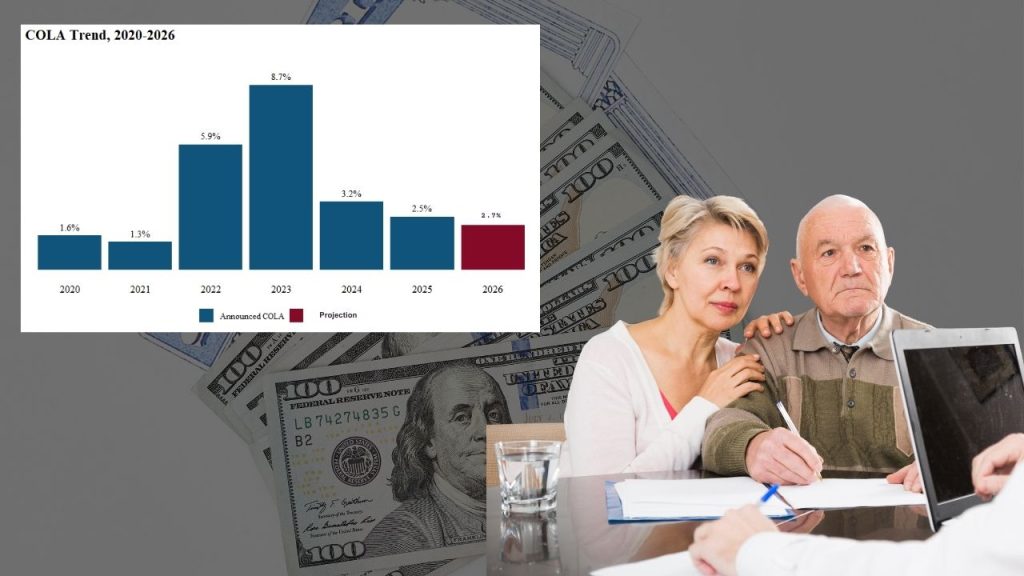The Social Security Cost-of-Living Adjustment (COLA) for 2026 is projected to be around 2.7%, providing a modest increase to monthly benefits for millions of Americans. This adjustment is vital because it ensures that Social Security payments keep pace with inflation, helping retirees, disabled individuals, and survivors maintain their purchasing power despite rising living costs.

However, experts warn that despite this increase, many beneficiaries may still struggle to keep up with the costs of essentials like housing, healthcare, and food, which tend to rise faster than the general inflation rate.
Social Security Cost-of-Living Adjustment Could Hit 2.7% in 2026
| Category | Details |
|---|---|
| Projected COLA Increase | 2.6% to 2.7% |
| Effective Date | January 2026 |
| Calculation Basis | Consumer Price Index for Urban Wage Earners and Clerical Workers (CPI-W) July-Sept 2025 vs. 2024 |
| Affected Beneficiaries | Retired workers, Social Security Disability Insurance (SSDI), Supplemental Security Income (SSI), survivors |
| Average Monthly Increase | Approximately $49 for average retired worker |
| Inflation Impact on Seniors | Healthcare, housing, and food costs rising faster than CPI-W |
| Official Announcement Date | October 2025 |
| Official Source | Social Security Administration Website |
The 2026 Social Security Cost-of-Living Adjustment of around 2.7% offers a necessary but modest boost to benefits amidst ongoing inflation pressures. While it helps maintain the purchasing power of millions of retirees, disabled individuals, and survivors, it may still fall short in fully covering the higher costs of living many seniors face, especially in healthcare and housing.
Planning ahead by reviewing budgets, exploring additional income sources, and maximizing benefits can help Social Security recipients navigate these challenges.
Understanding Social Security COLA: What Is It and Why Does It Matter?
The Cost-of-Living Adjustment (COLA) is an annual increase to Social Security benefits designed to offset inflation. Inflation means the price of goods and services rises over time, reducing the buying power of money. Without COLA, monthly Social Security payments would lose value year after year, leaving beneficiaries worse off.
The Social Security Administration (SSA) determines the COLA by comparing the Consumer Price Index for Urban Wage Earners and Clerical Workers (CPI-W) during the third quarter (July, August, and September) of the current year with the same period of the previous year. This CPI-W measures price changes for a basket of goods and services commonly bought by working-age urban households.
While the CPI-W helps estimate inflation, it has limitations. It does not reflect the unique spending patterns of seniors, who often face higher costs in healthcare, prescription drugs, and housing, which the CPI-W may not fully capture.
How the 2026 COLA Will Impact Social Security Beneficiaries
What Does a 2.7% Increase Look Like?
For the average retired worker receiving about $1,900 per month in benefits in 2025, a 2.7% COLA increase translates to about $49 extra per month starting in January 2026. Annually, this is an additional around $588 in income.
While this increase helps, it’s important to recognize that the cost of critical expenses, such as housing, food, and healthcare, may rise faster than the 2.7% increase. This means many seniors might find that their benefits do not stretch as far as they need.

Which Benefits Are Adjusted?
- Retirement Benefits: Monthly payments to retirees will increase by the COLA percentage.
- Disability Benefits: Social Security Disability Insurance (SSDI) recipients will see similar increases.
- Supplemental Security Income (SSI): Affected payments will also be adjusted proportionally.
- Survivor Benefits: Those receiving survivor benefits will benefit from the increase as well.
Timeline for 2026 COLA Announcement
- October 2025: SSA will announce the official COLA figure based on finalized inflation data.
- December 2025: Beneficiaries will receive updated benefit notices with the new payment amounts.
- January 2026: Increased payments based on the 2026 COLA go into effect.
Why Might the COLA Increase Fall Short for Many Seniors?
The core issue lies in how inflation is measured. The CPI-W is based on typical household spending patterns that do not prioritize senior-specific expenses, such as:
- Prescription medications
- Long-term care and assisted living
- Specialized medical equipment
- Rising housing costs, including rent and property taxes
For these categories, price increases have historically outpaced the overall inflation rate. For example, in recent years:
- Housing costs rose by about 3.9%
- Healthcare expenses increased approximately 2.8%
- Food and essentials grew by 3.0%
Meanwhile, the CPI-W inflation rate was about 2.4% in comparison. This mismatch means that even after receiving the COLA increase, many seniors face a net loss in purchasing power as their essential expenses climb faster than their benefits.
Practical Advice for Social Security Beneficiaries Preparing for 2026
While you cannot control the COLA calculation, there are steps to prepare financially:
1. Review and Adjust Your Budget
- Anticipate modest increases in income due to COLA.
- Factor in rising costs of healthcare, housing, and food.
- Prioritize essential spending and look for areas to reduce discretionary expenses.
2. Evaluate Healthcare Plans Annually
- During Medicare open enrollment, compare plans to find lower premiums or better coverage.
- Investigate supplemental insurance options to help cover out-of-pocket costs.
3. Explore Additional Income Sources
- Consider part-time work or freelance opportunities to supplement income.
- Look into government or community assistance programs available for seniors.
4. Maximize Benefits and Support
- Check eligibility for state and local aid such as property tax relief or energy assistance.
- Utilize resources from organizations focused on senior welfare for advice and support.
Social Security Payments Up to $5,108 Arriving Tomorrow as SSA Confirms Major Change
Garnishments Draining Your Social Security? Here’s How to Stop Losing Half Your Check
Social Security Payments Are Arriving This Week — Find Out If You’re Getting Yours
FAQs About Social Security Cost-of-Living Adjustment Could Hit 2.7% in 2026
What is the official COLA for 2026?
The official COLA will be announced by the Social Security Administration in October 2025, with estimates currently around 2.6% to 2.7%.
How is COLA calculated?
COLA is based on the percentage change in the Consumer Price Index for Urban Wage Earners and Clerical Workers (CPI-W) for July through September compared to the same months the previous year.
Will the COLA cover my increase in living expenses?
COLA aims to adjust benefits for inflation; however, it might not fully cover increased costs in healthcare, housing, and food that tend to rise faster than general inflation.
How much will my monthly Social Security check increase?
For an average retired worker earning about $1,900 per month, the estimated increase is around $49 per month in 2026.
When will I start receiving the increased payment?
The COLA increase takes effect in January 2026, with updated payments reflecting the increase starting that month.





